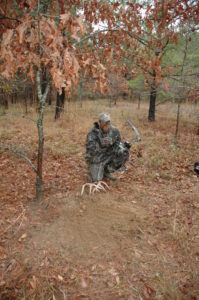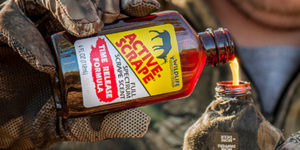Few things fuel a deer hunter’s imagination like a fresh scrape. As you see those freshly pawed leaves and see that licking branch dangling in a tantalizing fashion, images of giant antler immediately cross our minds. However, the majority of scraping activity occurs at night and hanging a stand by that newly-found sign may not be a good strategy.
Location, Location, Location
 A scrape’s location has much to do with its “hunt-ability.” If you find scrapes along the edge of a field, food plot, or logging road, those are most likely made by bucks checking for does at night. You may get action at such places just before dark, but the likelihood isn’t good. However, if you can locate a large scrape on the edge of a bedding area where several trails intersect, hang your stand well down wind of that location. Additionally, look for a rub line which may indicate the path a major buck is taking toward the spot.
A scrape’s location has much to do with its “hunt-ability.” If you find scrapes along the edge of a field, food plot, or logging road, those are most likely made by bucks checking for does at night. You may get action at such places just before dark, but the likelihood isn’t good. However, if you can locate a large scrape on the edge of a bedding area where several trails intersect, hang your stand well down wind of that location. Additionally, look for a rub line which may indicate the path a major buck is taking toward the spot.
Make Your Own
I once received a magazine article assignment in late winter about hunting scrapes. I  selected a likely location, found a large, pointed stick and made a scrape in the same way as a buck would do. As I circled downwind to photograph the pawed ground, the smell of “fresh earth” nearly knocked me down. it was a powerful, pungent smell that a deer could easily smell from long range.
selected a likely location, found a large, pointed stick and made a scrape in the same way as a buck would do. As I circled downwind to photograph the pawed ground, the smell of “fresh earth” nearly knocked me down. it was a powerful, pungent smell that a deer could easily smell from long range.
Whenever you make a false scrape, as you will see in this video, always “freshen” the earth with a pointed stick to add extra drawing power. You are about to see some great bucks visiting scrapes day and night. Here’s how to maximize you chances at one of them.



















![The Best Deer Camp Chili [VIDEO] Deer Chili Ingredients, Tomatoes, Chili Spices](/wp-content/uploads/2015/10/Deer-Chili-Deer-Camp-Recipe-218x150.jpg)
![How to Call Elk Early in the Season [VIDEO]](/wp-content/uploads/2016/08/byers003-218x150.jpg)



![Idiots Disturb Hunter: How Would You Have Handled It? [VIDEO]](/wp-content/uploads/2015/10/DSC00110-e1474487693878-100x70.jpg)
![Albino Buck Shocked to Shed His Antlers [VIDEO]](/wp-content/uploads/2015/10/AlbinoDeer-100x70.jpg)